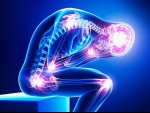Home »
Blog » Pain Management
| Stem Cell, PRP, Acupuncture in Queens & Long Island, New York
Pain Management | Stem Cell, PRP, Acupuncture in Queens & Long Island, New York
When a disc in your lower spine bulges or tears, you may feel pain in your lower back and/or your leg. Here are 3 unique signs of a herniated or protruding disc to help you identify the underlying cause of your lower back problem: 1. Pain While Sitting - An activity that exerts tremendous pressure on your lower spinal discs is sitting. If you have a herniated or bulging disc, this increase in pressure within your disc may cause the bulge to become more pronounced, which may aggravate your lower back pain when you sit.
Read more
What Are Calf Muscles? There's a group of muscles on the back of each lower leg that doctors call "calf muscles." They play a key role in helping you walk and run. Lots of things can make them hurt, from a minor sprain to more serious problems like deep vein thrombosis
Muscle Cramp - If you work your calf muscle too much, you can get a sudden pain in your leg. A muscle cramp can also happen if you hold a position too long or haven't had enough water to drink.
Read more
Now that we are entering a new phase in the COVID-19 pandemic where access to vaccines is high, infection rates are declining, and there is greater access to health-related services, this might be a time to reevaluate your pain management plan and consider what changes can make a positive impact. Let’s start by taking a look at some of the ways the pandemic may have increased your pain problem:
Emotionally drained. Certainly, life during COVID-19 has been a source of intense stress.
Read more
In response to America’s opioid epidemic, physicians, pharmacists, and even insurance companies have been increasingly raising the bar on who can receive opioid medications in addition to how much and for how long. It’s not just the addiction risk that calls for caution when using opioids to treat chronic neck or back pain though long-term use of opioids may also worsen the pain.
Read more
Nonsteroidal anti-inflammatory drugs (NSAIDs) treat pain. They also relieve inflammation and reduce fevers. Over-the-counter NSAIDs include pills like aspirin, ibuprofen, and naproxen sodium, and creams you apply to your skin. Your doctor can also prescribe these pain relievers in a high-dose or more targeted version, like celecoxib (Celebrex) for arthritis.
Read more
Over the past year, the COVID-19 pandemic has forced me to change how I evaluate, treat, and interact with my patients. Maintaining all of the necessary safety measures have pushed me to find new ways to comfort and connect with patients even though I can’t hold their hand or share a smile through my mask. I know my patients have had to make adjustments as well; they’ve had to learn new ways to relate to me and to others on their health care team. But in spite of all of the new hurdles created by the virus, there do seem to be some lessons in all of this that will improve the doctor/patient relationship.
Read more
If you have tried different types of office chairs and your back pain still persists, you may need to move on from the conventional seated-chair design to an alternate method. Here are 5 options to consider try a few out, to see which ones work best.
1. Standing Desk - A raised desk allows you to work while standing. Standing engages your core muscles more than sitting, and it can lead to better posture and spinal alignment. Switching between sitting and standing can also help manage chronic back pain.
Read more
Fibromyalgia - Fibromyalgia is a condition that makes your muscles ache and feel stiff. If you have it, you may be more sensitive to pain than most people. You’ll also feel the pain all over your body, on both sides and above and below your waist. You may have fatigue and brain fog, too.
Lyme Disease - In the first 3 to 30 days after you get a bite from a tick infected with Lyme disease, you may notice muscle and joint aches along with rash, swollen lymph nodes, fever, and chills. If you have these symptoms, see your doctor. Left untreated, Lyme disease can cause your joints to get stiffer and more painful over time.
Read more
A growing number of people are reporting lingering symptoms after overcoming their initial bout with COVID-19. "Long-haul COVID" refers to a condition where a person doesn’t feel fully recovered from their illness, even months later, after the infection has resolved. Initial reports indicate that one of the consequences of even milder COVID-19 infections can include persistent pain, including painful joints or muscles, splitting headaches, and chest pain.
Read more
An inflamed spinal nerve in your neck (cervical spine) may result in neck, shoulder, and/or arm pain. In response, your doctor may advise you to get a cervical selective nerve root block injection to help locate the spinal nerve that is pinched or inflamed, and also to relieve your pain. Here is how this procedure works.
Read more
Love this Post? Spread the World






















